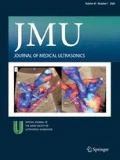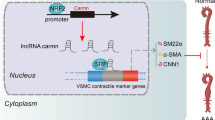Abstract
Purpose
The purpose of this study is to investigate the involvement of microRNAs (miRNAs) in sonication-induced apoptosis.
Methods
U937 cells derived from human leukemia were sonicated with 1-MHz ultrasound at 0.4 W/cm2 and 10 % duty factor for 60 s, a condition inducing apoptosis. The total RNA was extracted from cells at various timings after sonication and subjected to microarray and real-time PCR for miRNA expression analyses.
Results
Expression of several miRNAs was significantly affected by sonication. For miR-424* and miR-720, whose expressions were eminently decreased by sonication, cell lines overexpressing these miRNAs were established. Conversely, for miR-663B and miR-663, whose expressions were eminently increased by sonication, cell lines inhibiting these miRNA functions were established. When these cell lines were sonicated, a cell line inhibiting miR-663B function significantly increased sonication-induced apoptosis, suggesting this may be involved in cellular responses to sonication. Two genes that could induce apoptosis, KSR2 and CREBZF, were identified as potential target genes of miR-663B since potential target sequences on their 3′ UTR mediated to decrease expression of a reporter gene.
Conclusion
These results suggest that miRNAs may be involved in cellular responses to ultrasound through their expression changes caused by sonication.



Similar content being viewed by others
References
Suslick KS. Sonochemistry. Science. 1990;247:1439–45.
Riesz P, Kondo T. Free radical formation induced by ultrasound and its biological implications. Free Radic Biol Med. 1992;13:247–70.
Lagos-Quintana M, Rauhut R, Lendeckel W, et al. Identification of novel genes coding for small expressed RNAs. Science. 2001;294:853.
Lee RC, Ambros V. An extensive class of small RNAs in Caenorhabditis elegans. Science. 2001;294:797.
Farazi TA, Juranek SA, Tuschl T. The growing catalog of small RNAs and their association with distinct Argonaute/Piwi family members. Development. 2008;135:1201–4.
Stefani G, Slack FJ. Small non-coding RNAs in animal development. Nat Rev Mol Cell Biol. 2008;9:219–30.
Oh JS, Kim JJ, Byun JY, et al. Lin28-let7 modulates radiosensitivity of human cancer cells with activation of K-Ras. Int J Radiat Oncol Biol Phys. 2010;76:5–8.
Wilmink GJ, Roth CL, Ibey BL, et al. Identification of microRNAs associated with hyperthermia-induced cellular stress response. Cell Stress Chaperones. 2010;15:1027–38.
Fornari F, Gramantieri L, Giovannini C, et al. MiR-122/cyclin G1 interaction modulates p53 activity and affects doxorubicin sensitivity of human hepatocarcinoma cells. Cancer Res. 2009;69:5761–7.
Kulshreshtha R, Ferracin M, Wojcik SE, et al. A microRNA signature of hypoxia. Mol Cell Biol. 2007;27:1859–67.
Tabuchi Y, Kondo T, Ogawa R, et al. DNA microarray analyses of genes elicited by ultrasound in human U937 cells. Biochem Biophys Res Commun. 2002;290:498–503.
Abdollahi A, Domhan S, Jenne JW, et al. Apoptosis signals in lymphoblasts induced by focused ultrasound. FASEB J. 2004;18:1413–4.
Ashush H, Rozenszajn LA, Blass M, et al. Apoptosis induction of human myeloid leukemic cells by ultrasound exposure. Cancer Res. 2000;60:1014–20.
Sambrook J, Russell DW. Molecular cloning: a laboratory manual. 3rd ed. Cold Spring Harbor: Cold Spring Harbor Laboratory Press; 2001.
Sellins KS, Cohen JJ. Nuclear changes in the cytotoxic T lymphocyte-induced model of apoptosis. Immunol Rev. 1995;146:241–66.
Haraguchi T, Ozaki Y, Iba H. Vectors expressing efficient RNA decoys achieve the long-term suppression of specific microRNA activity in mammalian cells. Nucleic Acids Res. 2009;37:e43.
Ebert MS, Sharp PA. MicroRNA sponges: progress and possibilities. RNA. 2010;16:2043–50.
Honda H, Kondo T, Zhao QL. Role of intracellular calcium ions and reactive oxygen species in apoptosis induced by ultrasound. Ultrasound Med Biol. 2004;30:683–92.
Simone NL, Soule BP, Ly D, et al. Ionizing radiation-induced oxidative stress alters miRNA expression. PLoS ONE. 2009;4:e6377.
Mason TJ. Therapeutic ultrasound an overview. Ultrason Sonochem. 2011;18:847–52.
Rosenthal I, Sostaric JZ, Riesz P. Sonodynamic therapy—a review of the synergistic effects of drugs and ultrasound. Ultrason Sonochem. 2004;11:349–63.
Ogawa R, Lee SI, Izumi H, et al. Enhancement of artificial promoter activity by ultrasound-induced oxidative stress. Ultrason Sonochem. 2009;16:379–86.
Watanabe A, Kakutani S, Ogawa R, et al. Construction of artificial promoters sensitively responsive to sonication. J Med Ultrason. 2009;36:9–17.
Eker OF, Quesson B, Rome C, et al. Combination of cell delivery and thermoinducible transcription for in vivo spatiotemporal control of gene expression: a feasibility study. Radiology. 2011;258:496–504.
Acknowledgments
This research was supported by the Research and Development Committee Program of The Japan Society of Ultrasonics in Medicine. The authors thank Drs. Loreto B. Feril, Jr., and Go Kagiya for their critical reading of the manuscript.
Author information
Authors and Affiliations
Corresponding author
About this article
Cite this article
Ogawa, R., Morii, A. & Watanabe, A. Ultrasound stimulation induces microRNA expression changes that could be involved in sonication-induced apoptosis. J Med Ultrasonics 39, 207–216 (2012). https://doi.org/10.1007/s10396-012-0364-9
Received:
Accepted:
Published:
Issue Date:
DOI: https://doi.org/10.1007/s10396-012-0364-9




